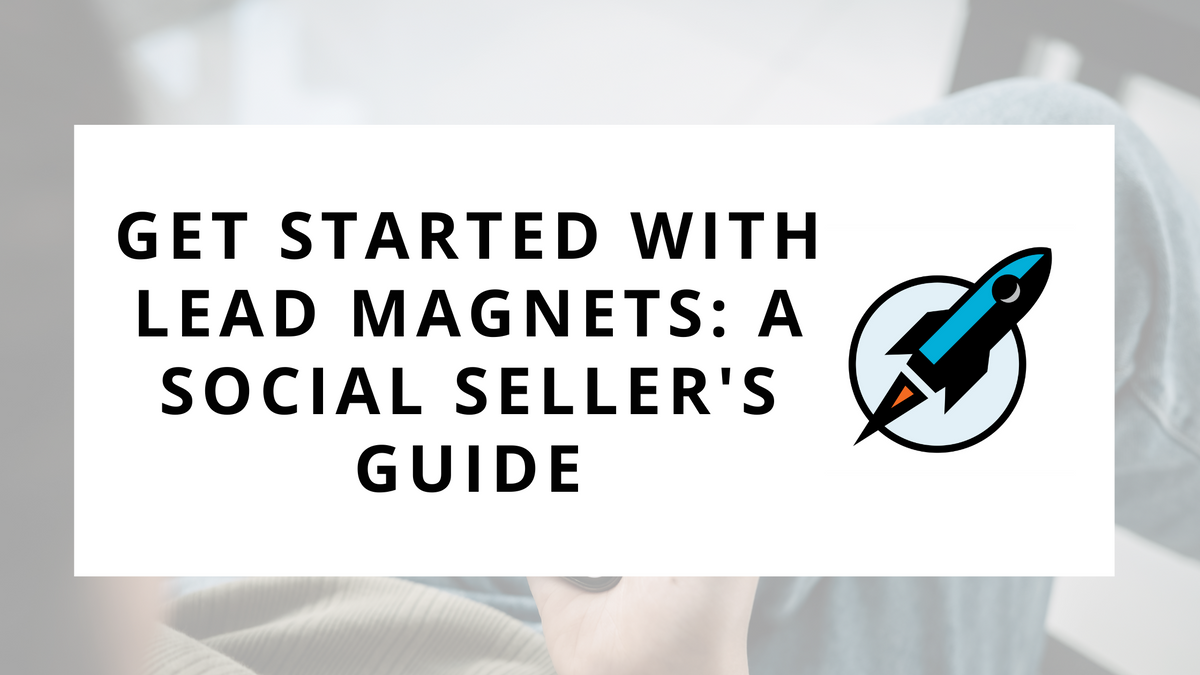Get Started with Lead Magnets: A Social Seller's Guide

Leads are the lifeblood of any sales organization.
But how do you entice social media followers or website visitors to share their valuable contact information with you willingly? The answer lies in the art of lead magnets.
In this week’s Sell with Social, we'll explore what lead magnets are, why they are essential, and how to create and leverage them effectively in your social selling strategy.
What are Lead Magnets?
Lead magnets are valuable resources that businesses offer to potential customers or leads, in exchange for their contact information, typically their email addresses.
These resources serve as the "magnet" that attracts individuals to your brand and encourages them to take action. Lead magnets can come in various forms, but their primary purpose is to provide value and solve a problem for your target audience.
From a sales perspective, they offer a powerful way to create sales conversions higher up in the buyer’s journey.

Instead of relying on your prospects being ready to “Get a quote” or “Book a demo,” your lead magnets provide a way to engage your prospects earlier. You can offer a valuable “Planning Guide” or “Getting Started Checklist” to prospects just starting to do their purchase research.
And because lead magnets allow you to provide value earlier in the sales process, you’re more likely to be the first salesperson to provide value. This is vitally important, as data from Corporate Visions found that 74% of buyers chose the company that was the first to add value.
So, not only do lead magnets help you generate more leads, but they also increase the likelihood you win those opportunities.
How to Create Lead Magnets
The next natural question is, “How do you create a lead magnet?”
The process itself is pretty straightforward. Your goal is to create a valuable resource that helps assist your prospects with a pain point early in their buying process.
The steps look like this:
Step 1 - Know Your Audience - Understand your target audience for the lead magnet. I find it helpful to know who I’m creating the resource for. Utilize a customer persona to ensure that you create a lead magnet that resonates with your ideal buyer.
Step 2 - Know Their Buyer’s Journey - Understand the buying journey of your target audience. Consider the pain points at each stage of the buying process and how you can help address them through a valuable resource. You’ll primarily be targeting the problem awareness or solution research stages.
Step 3 - Create a Valuable Resource - Now it’s time to create the lead magnet. Ensure that your lead magnet genuinely helps your audience and solves a specific problem. Use the list of lead magnet ideas below to help get you started.
Step 4 - Design it Professionally - Invest in professional design and presentation to make your lead magnet visually appealing. The more polished your lead magnet, the more valuable it will appear to your audience.
Step 5 - Publish and Distribute - Last, you’ll need to publish a landing page or conversion event for the lead magnet. Streamline the process (as much as you can) between your marketing platforms, CRM, and delivery of the resource itself. Once it’s live, it’s time to distribute it through your sales and marketing channels!
The steps above can be repeated as your team develops new lead magnets. Some resources, like a one-page downloadable checklist, will be simple and quick to create. Other resources, such as a comprehensive planning guide, might be a more significant undertaking.
The big key here is to focus on solving a problem for your ideal customer. Find a way to give them an early win in their buying process.
10 Lead Magnet Ideas
Ready to get started? There are many different lead magnets that you can create for your strategy.
Here are ten different ideas you can use to get started:
- Newsletters - Offer a subscription to your newsletter, where subscribers receive regular updates, tips, and exclusive content. This is one of my favorite lead magnets, as it provides ongoing value to your audience.
- Resource Guides - Offer an in-depth, comprehensive guide related to your industry or niche. Planning guides are perfect for more complex sales cycles to capture early leads.
- Free Consultations - Provide an initial consultation meeting or call. While labor-intensive, they allow you to start building a relationship quickly.
- Webinars - Host live or recorded webinars on a relevant topic and allow participants to access the recording in exchange for their email address. Ensure your webinar's content is focused on your audience’s problem, not your product.
- Mini Courses - Offer short, educational lessons delivered over several days or weeks. These are great for finding committed prospects who are interested in taking action.
- Whitepapers - Share in-depth reports or whitepapers that provide industry insights, research findings, or expert analysis. Ensure the content is not about your business, but more about insights into solutions your audience seeks.
- Templates - Offer ready-to-use templates, worksheets, or planners that make a task easier.
- Checklists - Offer downloadable checklists that help users solve problems or complete tasks more efficiently.
- Free Trials - Allow potential customers to try out your product or service for a limited time in exchange for their contact details. These tend to work better for products with shorter sales cycles.
- Interactive Tools - Create calculators, quizzes, or assessment tools that provide personalized results. While these typically require custom programming, they can be a valuable sales tool.
Hopefully, those ideas will be enough to get you started! But certainly don’t limit yourself to those lead magnets listed above. Spend time brainstorming ideas with your team, with a special consideration on solving your ideal customer’s problems.
How to Use Lead Magnets in Social Selling
You’ve built the perfect lead magnet for your ideal customer… now what?
Once you’ve created your lead magnet, it’s time to start leveraging it in your social selling strategy. You’ll want to find ways to include it throughout your social media presence, including your profile, posts, and direct messages.
On Your Profile
As the primary landing page of your social selling activity, your LinkedIn profile is the perfect spot to promote your lead magnet(s).
If you have creator mode enabled, you can add a link to a lead magnet as the call to action at the top of your profile.

Another great spot is to include lead magnets as attachments in your profile's “Experience” section. You can even add more than one to this section.

In Your Posts
Your posts provide another excellent opportunity to distribute your lead magnets.
This can be done by making the post about the lead magnet itself, or by linking to a related lead magnet based on the post's topic.

The more valuable your lead magnet is, the more directly you can promote it in the post. Ideally, your lead magnet should be such a great resource that it shouldn’t need to be forced into the content.
Bonus tip - Be sure to pin your lead magnet posts to your profile. This will add it to your profile's “Featured” section, increasing its visibility to your audience.

Messages and Comments
Lead magnets are also great tools for direct messages and LinkedIn comments. They enable you to provide value in your follow-ups.
This strategy is most helpful when you can align your lead magnets with other content, such as how-to videos, webinars, etc., and then follow up with a lead magnet offer in the comments and direct messages.
For example, if I did a presentation on how to schedule your social selling activity, I could follow up with a message sharing a link to our free 5-Day Social Selling Planner.
While this approach is more involved than simply sharing the lead magnet in a post, your conversions will be higher with this high-intent audience.

For this week’s action items, I want you to consider how you are using lead magnets as part of your social selling strategy.
Start to take advantage of ways to both generate more leads, as well as provide value earlier on in the sales process!
Take action on the following:
- Review Your Existing Resources - Start by looking at what valuable resources your company already has available. Do you already have lead magnets? Can an existing piece of content be turned into one? See if you can avoid starting from scratch.
- Update or Create a Valuable Lead Magnet - Use the five steps above in the article to create your lead magnet. To re-iterate, the focus should be on ways to provide real value to your target audience. Give your prospects an early win (and get a lead in the process).
- Promote Your Lead Magnet - Begin to promote your lead magnet. Add it to your profile, post about it, and share it in your outreach messages. You’ll be shocked at how many people will engage with your lead magnets once you share them regularly.
Questions about your lead magnet strategy? Reply to this email or drop them in the comments below!
